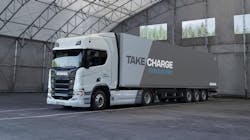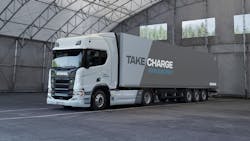U.S. Signs Non-Binding MOU to Make Trucks and Buses All-Electric by 2040
A few days before we sat down for Thanksgiving dinner, the U.S. announced at the United Nations Framework Convention on Climate Change (COP27) that it would sign a Global Memorandum of Understanding (Global MOU) on Zero-Emission Medium- and Heavy-Duty Vehicles (MHDVs).
And while you can’t always trust statistics, it’s tough to dispute the numbers attributed to greenhouse-gas emissions from commercial vehicles. MHDVs represent 10% of vehicles on the road in the U.S. but contribute 28% of total on-road greenhouse-gas emissions.
Studies have shown that a complete transition to 100% zero-emission commercial vehicles by 2050 could reduce domestic MHDV greenhouse-gas emissions by up to 73%, nitrogen-oxide (NOx) emissions by up to 93%, and particulate-matter emissions by up to 73% below 2020 levels. Analysis further shows that such avoided greenhouse-gas emissions could add up to 718 million metric tons by 2040 in the U.S., and 1,030 million metric tons by 2050.
The non-binding (there’s no penalty if this goal isn’t reached by 2040) Global MOU paves the way toward an electric and hydrogen-powered future. It sets a target for 30% of those new vehicles, which include commercial delivery vehicles, buses and trucks, to be zero-emission by 2030 and 100% by 2040.
U.S. Secretary of Energy Jennifer M. Granholm traveled to Sharm El-Sheikh, Egypt for COP27. At the U.S. Pavilion, the Secretary helped to showcase this year’s achievements from Net Zero World (NZW), the U.S. Department of Energy’s (DoE) program to accelerate the global transition to net-zero emissions launched last year at COP26 in Glasgow, Scotland.
“We have to work together across oceans and borders to meet our clean energy goals,” said Granholm.
Net Zero World
Under the Net Zero World Initiative, the United States is mobilizing the capabilities of nine U.S. government agencies, led by the DoE, to partner with philanthropies and countries to co-create and implement technical and investment pathways to accelerate the de-carbonization of global energy systems.
“The U.S. is committed to working with countries all over the globe to accelerate clean climate goals from ambition to action, and the Net Zero World Initiative is the latest example of our dedication,” said Granholm. “With Net Zero World, our partnering nations will harness the power and expertise of the national laboratories, federal agencies, think tanks, businesses, and universities to develop tangible clean energy projects that meet their energy needs.”
There are now 26 countries on four continents who have signed the Global MOU, including the United Kingdom, Canada, the Netherlands, New Zealand, Norway, Uruguay, Turkey, Austria, and, in the midst of fierce fighting, the Ukraine.
“Our country fully understands and supports important decisions on preserving the ecology of the planet,” said Oleksandr Kubrakov, Minister of Infrastructure for Ukraine. Ukraine is one of Europe’s largest truck markets. AVERE Ukraine, which is advancing electromobility in the country, was instrumental in bringing the Global MOU to Eastern Europe.
EPA Plans
A number of large companies, including truck manufacturer Scania and logistics giant DHL, also have endorsed the non-binding MOU. Since it first launched, private sector companies Ballard, Eaton, and Heineken have signed formal acknowledgements endorsing the ambition of the Global MOU.
New endorsers include AVERE, Brightmerge, Charge Across America, Commercial Vehicle Charging Europe (a joint venture of Europe’s biggest truck manufacturers, which will build at least 1,700 public charge points for heavy-duty vehicles in Europe by 2027), Heliox, ParkMyFleet, Phoenix Motorcars, REE Automotive USA, Siemens, Sono Motors, and Workhorse Group.
The U.S. Environmental Protection Agency (EPA) said earlier this year it plans to issue tougher greenhouse-gas emissions rules for heavy-duty trucks and other large vehicles. The proposed standards would reduce emissions of smog- and soot-forming NOx from heavy-duty gasoline and diesel engines and set updated greenhouse-gas standards for certain commercial vehicle categories. The agency plans to issue proposed rules in March 2023 and final rules by the end of December 2023.
U.S. national laboratories, together with in-country partners, have been engaged in modeling activities to provide the analytical underpinning for governmental decision-makers at the national and regional levels. This provides a platform for making informed climate and energy policy and investment decisions for the transition toward a net-zero future.
Making the switch to zero-emission MHDVs comes with multiple operational and business benefits. They include lower maintenance and fueling costs, improved handling, and lower vibration for drivers, as well as healthier air in the communities these vehicles serve.
As part of the Inflation Reduction Act, by transitioning to zero-emission vehicles, fleet owners and operators can stimulate job creation, and drive economic growth in the manufacturing sector. The $430 billion climate, tax and drug policy bill passed in August includes new commercial EV tax credits, with up to $7,500 for light- and medium-duty vehicles and up to $40,000 for heavy-duty vehicles.

